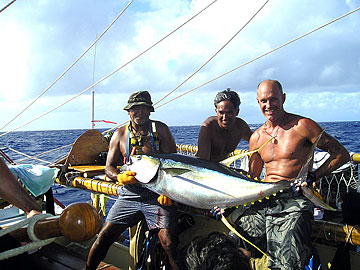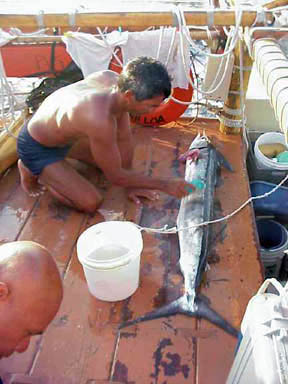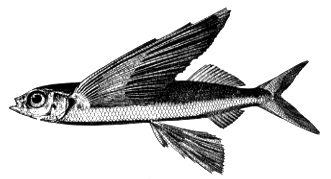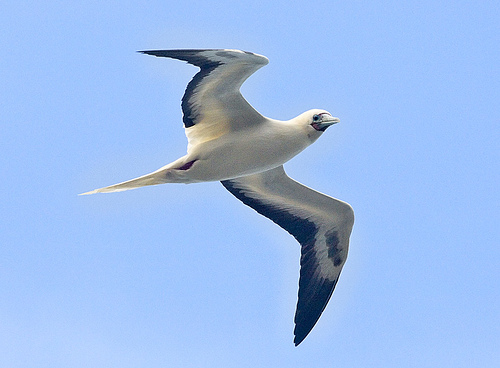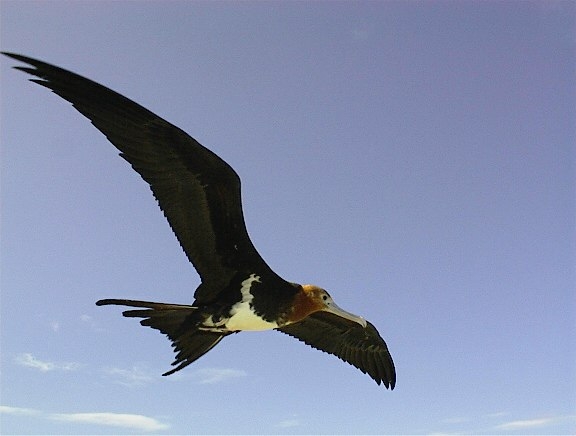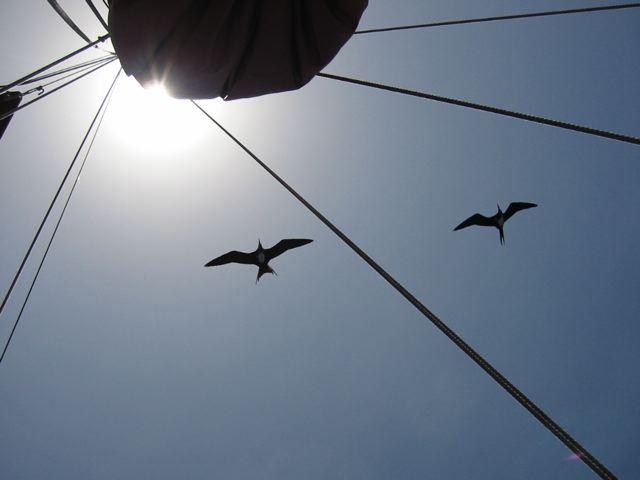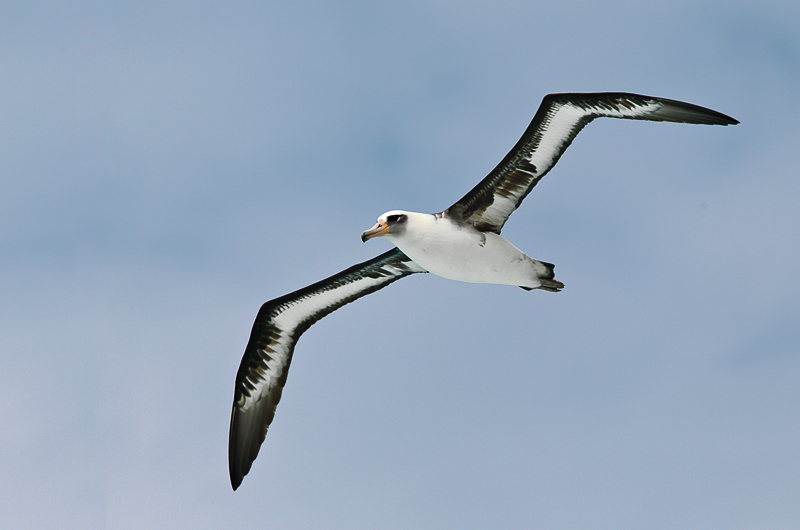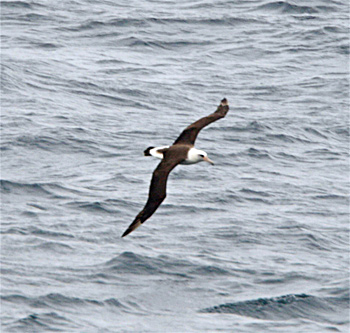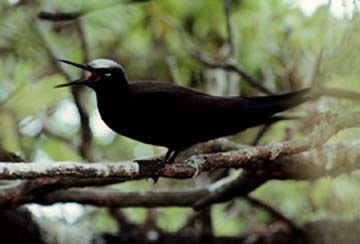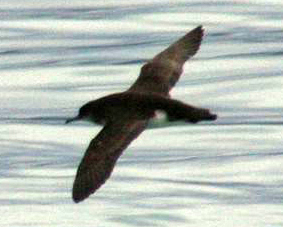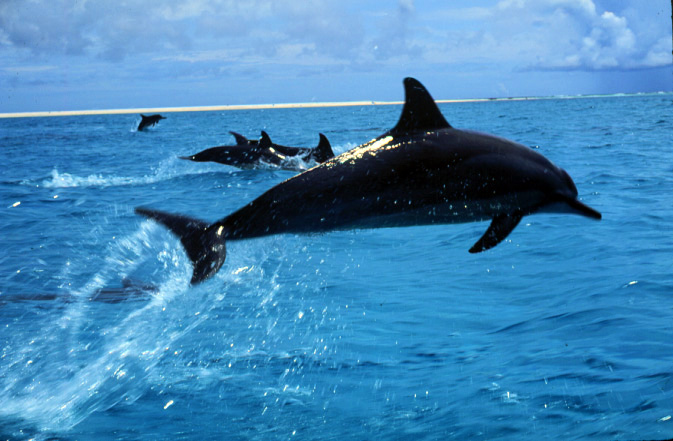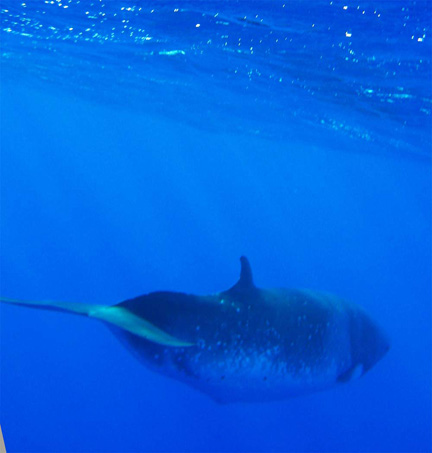Fish, Birds, and Mammals of the Open Ocean
Fish
'Ahi / Yellow-Fin TunaThe 'ahi grows up to 600 pounds; averages 75-200 pounds. It lives in warm waters, preferring 72-80 degrees. Migrates into Hawaiian waters between late spring and late summer or early fall. Feeds on squid, skipjack tuna and other small fish. Moves from surface to deep water in regular cycles during the day.
|
|
 |
Aku / Skipjack TunaThe aku grows up to 30 or 40 pounds. It is distributed in tropical waters worldwide. Travels in large schools and feeds on small fish, squid, shrimp and crustaceans. When the schools are near land, noio, or noddy terns, flock above the feeding schools of aku, attracted by the organisms driven to the surface by the fish. A highly prized fish for eating, cooked or raw.
|
A'u / BillfishA'u includes Marlin , Spearfish, Swordfish, and Sailfish. A'u-ki / Striped marlin (pictured below) averages 60-150 pound. Lives in tropical waters, preferring 68-74 degrees. Feeds on small fish and squid. A'u / Spearfish grows to over 60 pounds. Abundant in Hawaiian water, particularly in winter and early spring. Feeds on small fish and squid. A'u-lepe / Sailfish averages 60-70 pounds. Lives in tropical water, preferring 76-80 degrees. Feeds on small fish and squid.
|
|
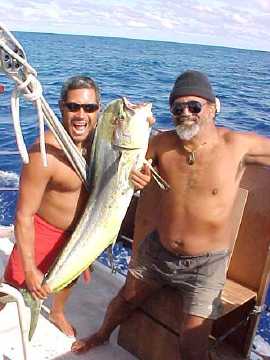 |
Mahimahi / Dolphin FishFound worldwide in tropical and warm temperate ocean waters, preferring 74-76 degrees. Averages 15-25 pounds, but grows up to 90 pounds, and over five feet long. Feeds on squid and small fish, such as the malolo, or flying fish. Packs of mahimahi may be found chasing schools of malolo, with 'iwa, or frigate birds, following overhead to catch the malolo as they leap from the water to escape the mahimahi.
|
Malolo / Flying FishMalolo are found in the open ocean and are called flying fish because they can glide over 100 yards above the surface of the water. They feed on small organisms, plants and animals and grow up to 18 inches. One species, the lelepo (night flyer) soars at night and, attracted to lights on boats, crash-land on the deck. |
|
|
|
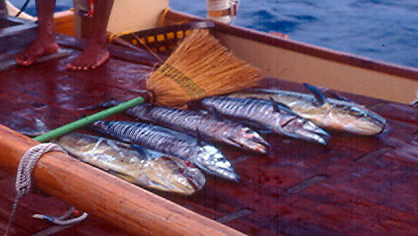 |
Ono / WahooThe ono averages 25-40 pounds, though it grow as large as 150 pounds. This torpedo-shaped fish is believed to swim over 50 mph; it has sharp teeth and feeds on flying fish, 'opelu (mackerel scad), and small tuna. Found in tropical and warm temperate waters, preferring 78-82 degrees. |
Birds
'A / BoobyBoobies are large birds that plunge-dive for fish, including mackerel scads, flying fish, goatfish, and dolphinfish. They often feed with other birds; fishermen look for these flocks to find schools of small fish which attract large fish. Boobies are distributed throughout the subtropical and tropical waters of the world's oceans and are capable of flying great distances. Young birds are nomadic; nesting adults return to home islands in the afternoon or at night. Boobies often follow vessels at sea; they rest on floating debris and have been seen riding on the backs of turtles. Types of boobies include Masked, Brown, Red-footed (pictured right).
|
|
'Ake'ake / Band-Rumped Storm Petrel |
'Ake'ake / Storm PetrelsStorm petrels are small , mainly black and white pelagic birds. They feed alone or in small groups on tiny fish, squid, shrimp, and other organisms. They fly low to the water, pattering with their webbed feet, which may be used to push off the surface; they are at home in storms at sea; they may rest on the ocean surface. They breed in burrows on remote islands.
|
'Iwa / Frigate BirdA large, wide-winged sea bird of the tropical seas (wing span up to 6 feet), the 'iwa soars for hours on updrafts and may stay at sea all night or for days. These birds sometimes travel great distances, though generally are non-migratory and stay within 50 miles of their home islands. As they are incapable of taking off from the surface of the water, they swoop down and pick fish just below the surface or leaping above the water (see mahimahi); or they may attack other birds in flight and steal the fish that their victims disgorge or drop. The 'iwa nests in remote areas or islands on bushes or vegetation. Westerners thought of the Frigate Bird as a bad omen; the Tahitians saw it as an embodiment of the war god 'Oro.
|
Photo by Na‘alehu Anthony |
Ka'upu / Albatross; Moli / Laysan AlbatrossThe largest seabird, the manu ka'upu or moli (albatross), can soar for hours, with wings outstretched and motionless (wing span = 6-7 feet), and remain at sea for months or even year-round, ranging over thousands of miles. Because of their hollow bones, they weigh only a few pounds.They fly too fast to feed on the wing, so they settle on the water, dipping their heads to feed. They eat fish eggs, fish, squid, and crustaceans. Cold-ocean birds, they are rarely seen feeding in the tropics. Birds that nest in Hawai'i fish the cold waters of the North Pacific. Albatrosses live long, mate for life, and produce only one egg every one or two years. They produce eggs from 7 or 8 years old until their 20's. Most of the world's Laysan (pictured at the right) and Black-footed albatrosses nest on the Northwestern and western Hawaiian Islands (Kaua'i, Ni'ihau, Ka'ula and O'ahu, around Ka'ena Point). Once at risk because they were hunted for their feathers, albatross populations have recovered and the bird is no longer considered endangered. Some albatrosses are killed when they swallow hooks baited with squid trailing from long-line fishing boats trolling for a'u, or swordfish. The birds are dragged into the water and drowned after swallowing the hooks. The U.S. Fish and Wildlife Service is working with longliners to come up with techniques to protect the birds, such as laying line at night, weighting hooks so that the bait is below the surface out of reach of the albatross, or disguising the bait with blue dye.(Jan TenBruggencate, "Help sought for over-eager albatross" Honolulu Advertiser, Feb. 16, 1999 A1+). In 1999, it was reported that adult albratrosses were abandoning their eggs and their young on Kaua'i and the Northwestern Islands of Hawai'i, perhaps because a shortage of food at their fishing grounds is forcing them to feed for survival rather than returning to their nests to feed their young (Jan TenBruggencate, "Albatrosses abandoning nests in record numbers," Honolulu Advertiser, march 7, 1999, A1+). In some cultures sailors believe that these solitary flyers of the open ocean are the souls of dead sailors, and that killing an albatross will bring bad luck. |
|
Ko'ae / Tropic BirdGraceful, acrobatic birds of the tropical oceans (between 30 degrees N and 30 degrees S), with long tail feathers, white or red. They nests on cliffs and in trees and may be seen inland in Hawai'ii over rain forests or volcanic craters, rising on updrafts. They plunge into the water to catch fish and squid, controlling their twisting, spiralling dives with their short wings as they target their prey. Air sacs in their necks break the impact. Pelagic, they are capable of long flight, flapping, then gliding; they rarely fish in sight of land; they occassionally rest on the surface of the sea, with tail cocked. Solitary, they sometimes follow vessels at sea, perhaps out of curiosity or looking for fish scattering before the prow.
|
|
Manu-o-ku / White TernManu-o-ku are white birds that dive for small fish at sea. They fly erratically but effortlessly above the waves. They roost and nest in trees or low vegetation or rocks. Colonies live in parks around Honolulu. Found in small flocks or alone. Like the noio, or noddy tern, they return to land daily, so their flights can be used as clues to the direction of land--from islands in the morning and to islands in the late afternoon, though they sometimes leave an island before dawn to return at dawn to feed their young. Non-breeding white terns sometimes range far from shore. Approximate Range from Land: 120 miles.
|
|
Noio / Noddy TernBrown or black, with the brown one larger, the noio nests in a range of habitat, from beaches to forest trees. Noddy terns feed in flocks by plunging or dipping for fish and squid; black noddies often fish near shore. These birds fish in the day and return to their home island at night; thus, like the manu o ku or white tern, their flight is a clue to the direction of an island, from the island in the morning, to the island in the late afternoon. Approximate Range from Land: 40 miles. |
|
ShearwatersMedium-sized, shearwaters fly near the surface, hence their name. They nest on remote islands, often in burrows. They are pelagic, spending most of their lives at sea, though during breeding season they may remain within 50 miles of their home islands. They take fish and squid at the surface and may pursue fish for short distances underwater. Various species include the Streaked, the Sooty, the Pink-Footed, the Flesh-Footed, the Little, the Giant (as large as an albatross), the Short-Tailed, and the Wedge-Tailed. The 'Ua'u Kani, or Wedge-tailed Shearwater (pictured left), is the most common tropical shearwater in the North Pacific. In Hawai'i, the Wedge-tailed Shearwater nests in remote areas like Ka'ena Point on O'ahu. A state-managed program for trapping cats, mongooses and dogs in the 23-acre Natural Area Reserve at Ka'ean has led to an increase in nesting birds; these land mammals are known to eat chicks and eggs of the shearwater and other nesting seabirds, such as the manu ka'upu, or albatross and the iwa, or frigate bird. (Bunky Bakutis, "Seabirds thrive after predator-trapping effort" Honolulu Advertiser Dec. 8, 1996 A23).
|
Mammals
Nai'a / DolphinSpinner dolphins are found in subtropical and tropical waters around the world, feeding on fish and squid. Five to eight feet long, they travel in schools of 5-200 or more,and will sometimes accompany a voyaging canoe, riding on the wave at the bow. At night, when they stir up phosphorescent organisms as they swim, they look like glowing torpedoes. |
|
WhalesKohola (Humpback Whale) are found in tropical to polar nearshore waters. In the northern Pacific, they migrate between Hawai'i (winter) and Alaska (summer), traveling singly, in pairs, or in groups up to 15. Thirty-five to sixty feet long, humpback whales are known for their seemingly playful behavior, waving their long flippers, splashing their tails or leaping from the water. A baleen whale, the humpback feeds on tiny organisms in the water. Sperm whales range offshore in tropical to subpolar waters around the world. This toothed whale feeds on giant deep-water squid and large fish. Males grow up to 65 feet long, females up to 56 feet. A large head (it has the largest brain of any animal) and a low hump on the back are other physical characteristics. Sperm whales can be identified at a distance by a spout from their blowhole, directed slightly forward and to the left. When they dive for food (up to 10,000 feet down, up to two hours long) their tail fins (flukes) lift from the water. Sperm whales travel in nursery schools of up to 50 females of all ages and immature males. A male school consists of sexually mature males. Mature bulls visit female schools during mating season. Short-finned Pilot whales are found in offshore warm temperate and tropical waters. They are smaller than sperm whales, growing up to 18-22 feet long, and have rounded, bulbous heads and pronounced dorsal fins. They live in groups of 10-60 individuals and are somtimes seen traveling with dolphins. They feed mainly on squid. |
Sources of Information
Carwardine, Mark, et al. Whales, Dolphins and Porpoises. Nature Company and Time-Life Books 1998.
Harrison, Craig S. Seabirds of Hawaii: Natural History and Conservation. Cornell University Press 1990.
Pratt, Douglas, Phillip L. Bruner, and Delwyn G. Berret. A Field Guide to The Birds of Hawaii and the Tropical Pacific. Princeton University Press 1987.
Rizzuto, Jim. Fishing Hawaii Style, Vol. 2. Honolulu: Fishing Hawaii Style, Ltd. 1987.
Titcomb, Margaret. Native Use of Fish in Hawaii. Honolulu: UH Press, 1972.

